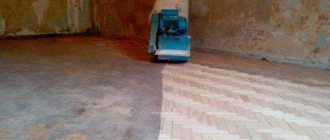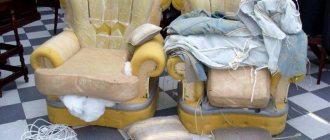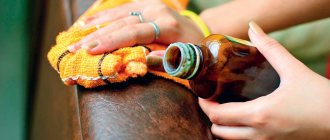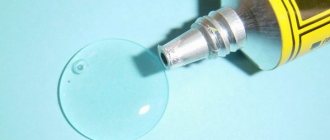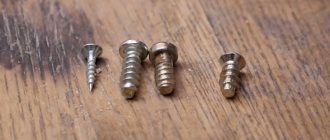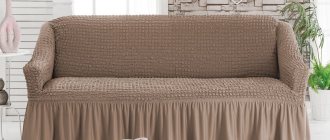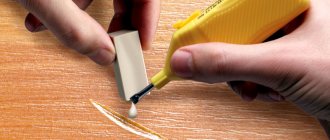If you are tired of your old wooden furniture, which has long lost its presentation, do not rush to throw it away. You can easily restore it to its former shine and beauty. To do this, you don’t need to be a professional restorer and you can easily transform old furniture at home.
This article will talk about removing the old paintwork - this is the first stage of preparing furniture for further transformation and decoration.
You can remove varnish and paint from the surface of wooden furniture by sanding or using special products containing a solvent. Read the details of each method in this material.
How to remove old varnish from furniture with solvent
To remove varnish from furniture at home, you can use a special varnish remover. Such products have high penetrating power and make it easy and quick to clean the surface.
But furniture can be treated with different varnishes on different bases, so it is necessary to choose a solvent that will not harm the furniture and will allow you to achieve results. But you can only remove varnish using solvents from wooden surfaces.
Before removing old varnish from furniture , you need to prepare the wooden surface of the furniture. First of all, it must be cleaned of contaminants. Over the years, a lot of grease and dirt has accumulated on its surface, which must be removed with ordinary soapy water.
Try to clean all the recesses, nooks and panels. Proceed carefully, the wood should not get too wet, and the soap composition should only clean the contaminated surface and not remove the coating from it.
It is better to treat panels and shaped parts of furniture with special solvents to remove old varnish.
There is no point in talking about how to remove varnish from old chipboard furniture, because... this cannot be done. Together with the varnish layer, the decorative layer that replicates this or that texture will be removed or significantly damaged.
What tools will you need?
In the process of removing old polish, you will need some tools that will help you get the job done faster.
What to prepare:
- construction hair dryer (an ordinary one will not work);
- blowtorch;
- hard metal scraper-brush;
- polyethylene film;
- regular paint brush (not hard);
- sponge;
- emery and sanding paper.
In addition, it is worth taking precautions to protect your hands and respiratory organs. Prepare a mask (preferably a respiratory type), rubber gloves and, if possible, safety glasses. Chemical compounds that are used to remove nail polish should not come into contact with the skin, and you should also beware of accidental inhalation of vapors.
Remove varnish from furniture by sanding
Using sanding, you can not only remove varnish, but also level the surface of wooden furniture. Sanding is done with sandpaper (abrasive) paper manually or using a sanding machine.
To make hand sanding easier, use a simple wooden block and wrap a piece of sandpaper around it.
To remove varnish from furniture , start sanding the surface with medium-grain paper, gradually moving to fine-grain paper.
A special sanding machine of small size and power will greatly simplify the removal of varnish. For such a machine, only fabric-based sandpaper is suitable.
After each sanding step, remove dust from the surface of the object with a slightly damp cotton cloth.
Before removing varnish from furniture , buy a special device with a grip for sandpaper at a hardware store. This will allow you to distribute the sanding pressure evenly.
To sand rounded and convex surfaces, move the sandpaper strip up and down at right angles.
We remove everything that interferes
In order to paint any object with high quality, you need to remove, if possible, everything that cannot be painted, and therefore gets in the way. Of course, you shouldn’t completely disassemble the furniture - what if you can’t put it back together? But it is necessary to remove the doors, remove the drawers and shelves, remove the glass and unscrew the handles and hinges.
Remove everything that interferes with painting. Carefully cover anything that interferes but cannot be easily removed with masking tape. If the part is curved and convex, you need to glue it in several layers, using small pieces of tape, as when working with papier-mâché. For more complete coverage and minimal joints, stick the strip with a small margin, so that you can then trim off the excess.
How and how to remove paint from a wooden surface
It is very difficult to completely remove old paint from the surface of furniture, but we will try. For this, special chemical solvents are most often used, which can be purchased at construction or specialized stores, as well as construction hair dryers.
Gently wash the surface of the product with a dishwashing sponge. Instead of a sponge, you can use foam rubber or cotton cloth. Remove soap solution and dirt from the surface of the furniture by wiping it with a soft cotton cloth, first slightly damp, then dry.
First, let's look at how to remove paint from furniture using a solvent and a metal spatula:
- Apply solvent with a synthetic flute brush. Sometimes it is necessary to apply several layers of solvent to remove a thick layer of paint. Follow the time recommended by the manufacturer.
- When the paint softens and begins to peel off the surface of the wood, scrape it off with a metal putty knife.
- Depending on the composition of the old paint and the number of layers, it may be necessary to reapply the solvent to achieve greater softening and swelling of the paint.
Acrylic paints do not adhere to surfaces that have been pre-treated with oil. To remove oil coating, soak steel wool in mineral spirits and rub the surface in a circular motion.
Chemical solvents for removing old paint and varnish are very toxic and require working outdoors or in a well-ventilated area. Then how and how to remove paint from a wooden surface if you do not have the opportunity to take the product to an open place? In this case, use a hair dryer. Working with it is more difficult, but safer for health. Direct a stream of hot air at the old paint and wait for it to swell, then remove the coating with a spatula or scraper.
Store products
Specialized stores have a wide range of products that allow you to remove the paint layer. Such compositions can be in the form of powders and pastes. These types are considered the most effective; they are diluted with water to a paste-like state and applied to the wood with a brush. Pastes and powders are the most effective because they remove up to 10 layers of varnish.
Gels and liquids supplied ready-to-use are less effective. They are also applied with a brush, but they can remove up to 3 layers of varnish. Sprays are considered the most convenient for use, however, their effectiveness is the least in comparison with analogues. After any of the above products are applied to the varnish coating, it must be covered with cellophane film. It is removed when the surface darkens and the varnish mixture becomes viscous, then the paint and varnish material is removed from the furniture using a spatula.
Restore furniture surface: a quick way
Having completed the job of removing old paint from furniture or doors, we often, unfortunately, discover that there is nothing good underneath - just putty and potholed wood. And now there is only more work to do with such a surface before applying new paint!
But you can use a quick way to restore the paint coating. To do this, follow the following instructions:
- To restore the surface of furniture, remove paint only in those places where it has peeled off using a metal spatula.
- Sand the surface of the product covered with old paint using a sanding machine, using first medium-grit sandpaper, then fine-grit sandpaper. Don't try to remove the paint, just smooth it out. If necessary, sand the entire surface of the product using the old paint, leveling and removing defects (for example, smudges and drops of old paint).
- Fill all cleaned areas using wood putty. The drying time for the putty is recommended by the manufacturer.
- After the putty has dried, sand the surface again - manually or using a sander.
- After this, wipe the product from dust and repaint the entire surface in two or three layers.
The surface prepared in this way can be repainted in any color, using the old coating as a primer.
When sanding, be sure to wear a mask to protect you from dust. Only work with chemical solvents outdoors or in a well-ventilated area and be sure to wear rubber gloves. Follow manufacturers' instructions regarding use, storage and disposal of solvent.
If your home is not the Hermitage, and the furniture is just an old shelf or bedside table, use this easy way to restore the paint finish.
Thermal method
When heated, the structure of the varnish coating changes, the varnish becomes more liquid, the degree of its adhesion to the wood decreases significantly, which means it will be much easier to remove. However, here you need to follow several rules. First of all, it is important to take care of protection, that is, use special glasses to protect your eyes during work, as well as thick gloves. Before starting the process, you need to open the windows so that the room is well ventilated (this is important, because toxic chemical elements can be released during the melting of the varnish, which increases the risk of developing poisoning and allergies). In addition, there are coatings with a special composition that, when heated, does not melt, but chars. In this case, it is better to choose another method of removing varnish.
Removing polishing, filling and priming furniture before its restoration
Before you start restoring old furniture, you need to remove the old polish, putty and prime the surface.
When starting to work with paints and varnishes, be sure to ventilate the room. Make sure you have a mask or respirator, rubber gloves, and eye protection in advance.
So, what aids will be needed:
- respirator,
- thick rubber gloves,
- newspapers, rags, rags,
- container with a wide neck,
- mineral spirits.
What else is needed to remove polish from furniture:
- sandpaper,
- metal wool,
- paper towels,
- putty knife,
- an old brush, preferably with natural bristles.
And most importantly, you need a special composition for removing polish . There are thick and liquid formulations. Thick compounds are more suitable for vertical surfaces. And liquid ones are for processing carved parts and hard-to-reach corners. In addition, they are used to apply the last layer of the composition.
To begin with, we will tell you how to remove old polish using a thick binder .
- Pour the binder (a little) into a container with a wide neck (you can take an old mug). Apply the composition with a brush in one direction to an area of approximately 50 by 50 cm.
- Then wait for the coating to soften (this time should be indicated on the packaging of the product). Please note that the composition is effective while it is wet. Typically, one layer of coating can be removed at a time.
- Then scrape off the coating in the direction of the wood fibers using a spatula. So you repeat all the operations until the natural wood appears. By the way, an old toothbrush will come in handy to remove the coating in inconvenient places.
- After this, take steel wool and wipe the furniture with it in order to remove any remaining coating and adhesive. If this was not enough, then you need to apply a thin layer of adhesive using steel wool.
- Then wipe the surface with a paper towel and let it dry. If there is a need and you need to correct the imperfections of the wood or remove traces of old paint and stain, then you need to treat the wood with coarse sandpaper.
- Finally, the surface of the restored furniture must be cleaned with fine-grain sandpaper and wiped with a rag.
How to remove old polish using a liquid compound ?
Pour a little mixture into the container. Dip steel wool there and squeeze out excess liquid. After this, rub the composition on a small area of the surface in a circular motion. This way the old coating will dissolve and be absorbed by the cotton wool. Repeat these steps until the surface is completely clean.
Remove the remaining coating and various stains using a clean compound and fresh cotton wool. Continue these steps until the furniture is perfectly aligned and shiny.
I would like to especially note that we have provided general recommendations for removing old polish. Of course, you need to read the instructions for use of each product to remove old coating from furniture.
Before applying a new decorative coating, the surface of the furniture must be puttied and primed.
Thanks to puttying, defects from the old surface are eliminated: various cracks and pits. You can use ready-made putties for wooden products, or you can use casein or wood glue, drying oils, varnishes and other products.
The putty is applied to the furniture to be restored using a spatula. In this case, tilt the spatula strongly and move it across the wood fibers or at an angle to them. Then remove the excess: place the spatula almost vertically and move it at an angle in the direction of the wood fibers. The surface dries for 24 hours, and then it can be sanded with sandpaper. It happens that the ideal surface is not obtained immediately. Then putty it again. To do this, dilute the mixture to the consistency of cream.
Thanks to priming, the adhesion of various finishing compounds (paints, varnishes, polishes) to wood is significantly improved. A high-quality primer is distinguished by the fact that it is easily applied to the surface, dries quickly, is insoluble with paints and varnishes, and is also easy to sand. Often, a special primer composition is not needed, since the paints or varnishes themselves also serve as a primer.
When you go to prime, be sure to test a small area to see if the primer matches the paint or varnish.
Before painting with enamel or oil paints, adhesive solutions are used as a primer, for example, office glue or natural drying oil.
Cleaning complex contaminants
Folk remedies also help to cope with difficult stains. In particular, to clean surfaces, you can sprinkle problem areas with flour and then wipe with vegetable oil.
Traces from hot dishes
To remove such marks, just put a small amount of salt in a cloth, roll up the bag and wipe the furniture. Then the surface must be treated with vegetable oil.
Wax drops
To get rid of the wax, you need to heat the knife and pry out the drops. After this, the problem area is rubbed with gasoline.
Ink stains
A mixture of beer and wax helps get rid of ink stains. This composition does not need to be boiled first. After treating stains, the mixture should be immediately washed off with water.
Heavy soiling
Heated 9% vinegar can remove such stains. You need to moisten a cotton swab in this liquid and then wipe the problem area.
Cleaning away traces of flies
White wine helps with such traces without adding other ingredients.
Unknown origin
To remove any stains, you can use vegetable oil, which should be mixed with ethyl alcohol.
Fat
Traces of fat can be easily removed with leftover tea leaves wrapped in cotton cloth.
Reasons for contamination of polished objects
As with any furniture, the main reason is dust settling on smooth tables, cabinets and bedside tables. But varnished surfaces not treated with antistatic agents have an increased ability to “attract” the smallest particles. Microcracks in the smooth layer also accumulate contaminants, which are difficult to remove. Therefore, the fight against dust on polished furniture is especially important.
Additional causes of pollution are:
- greasy fingerprints left after touching the polish;
- stains from any spilled liquid;
- stains from wet wiping of furniture that were not removed in time by additional polishing;
- stuck pieces of paraffin, wax or plasticine;
- traces from the impact of hot objects placed on the surface without gaskets.
In addition to dust, most pollution is created by one’s own hands as a result of negligence when handling furniture. You can avoid them by following simple rules. But we cannot rule out chance.
If stains do appear on polished furniture, you need to be able to remove them correctly without causing additional harm.
Methods for carrying out restoration measures
Analysis of the degree of wear of lacquered furniture
First, you need to analyze the current conditions of the furniture to be repaired. A good reason to start the restoration process will be deterioration in the appearance of the headset, including darkening in the thread area. In addition, a common reason for restoration is small cracks on the surface.
In cases where such defects are not very pronounced, they may not harm the appearance, but, on the contrary, add solidity to it. In the case of severe defects, there is a need for restoration measures, which are organized by a professional from a specialized workshop, or they can be carried out independently at home, while preserving the antique qualities of the furniture.
If something goes wrong, you can cover the product with paint at any time, although then the unique pattern inherent in the wood will be hidden by the paint and the furniture will lose its presentable appearance.
